Yeah, I said that I’d be comparing Gothic and Khmer art over the next few days, and that there would be flights to some other places in between.
I decided to do a post or two on Islam in Southeast Asia, and the memories of my immersions in the rich cultural crossroads have stoked me into doing a couple more posts before I get back on the original flight path. The above photo takes us to Bali, and there’s a connection with Islam because Islamic architecture in Southeast Asia has many roots that make up a cultural feast.
The public pavilion that you see has been a central feature of many villages in Southeast Asia since pre-historic times. On the mainland, and in Indonesia, Melanesia, Micronesia, and Polynesia many societies used them as men’s houses, in which people would govern the village, and conduct sacred rituals. Since this architectural form was already ancient and very wide-spread when the universal religions were imported, it was deeply embedded in people’s consciousness. They thus adapted it to the new faiths.
When Hinduism was imported early in the first millennium CE, some temples were also raised buildings with sloping roofs on all 4 sides. But the number of roofs increased to fit Hinduism’s many levels of heavens. Pura Besakih in Bali (shown above) is one of the finest examples.
Raised wooden homes are common throughout Southeast Asia. You can even see them in modern Kuala Lumpur, Malaysia (above). Royal palaces in Southeast Asia were much bigger versions of the wooden home on stilts.
So if you put these components together–the raised public pavilion in the village center with sloping roofs on all sides, wooden homes and palaces on stilts with gabled roofs, and raised Hindu temples with a stack of roofs that slope on all sides–you have a very multidimensional cultural background that shaped mosque architecture when Islam was imported.
Above is the oldest surviving mosque in Malaysia, which was built at Kampung Laut in the 17th century. It’s wooden, and raised on stilts, and its square prayer hall with multiple roofs became a common mosque form.
And you thus see it in the above mosque in Malacca, Malaysia.
But Southeast Asia doesn’t adhere to one form any more than a jazz musician plays in one key.
The minaret of the Malacca mosque looks a bit like a Chinese pagoda. In the 19th century, many Southeast Asian mosques were in Mughal Indian styles. But,
The modern national mosque in Kuala Lumpur blends the ancient gabled roofs of palaces, homes and some meeting houses with the new. Though Islam is a universal religion, Southeast Asia’s art forms are deeply embedded in people’s psyches. They continue to shape Islamic art, and Islam continues to modify them. Southeast Asia never runs out of cultural blends.
The next post shows that Southeast Asian domestic architecture is one of the world’s greatest art forms.
Yeah, I’m in a holding pattern over Southeast Asia–and I’m enjoying it like a big bowl of fish soup.

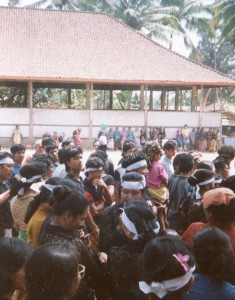
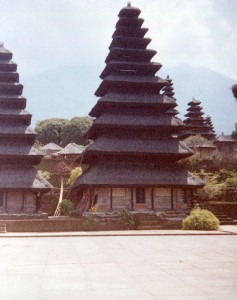
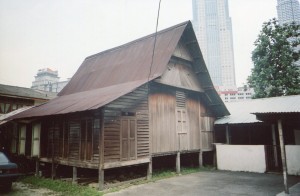

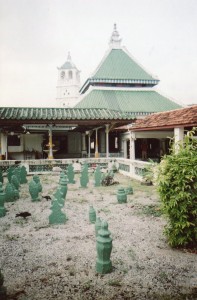
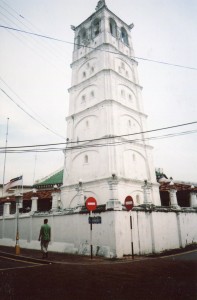
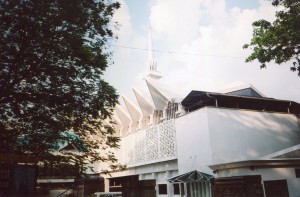
Comments on this entry are closed.